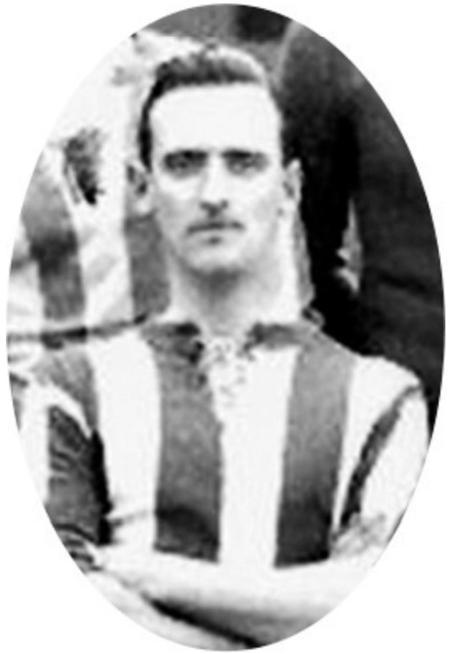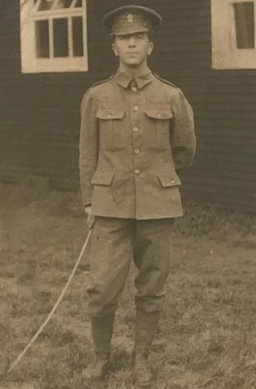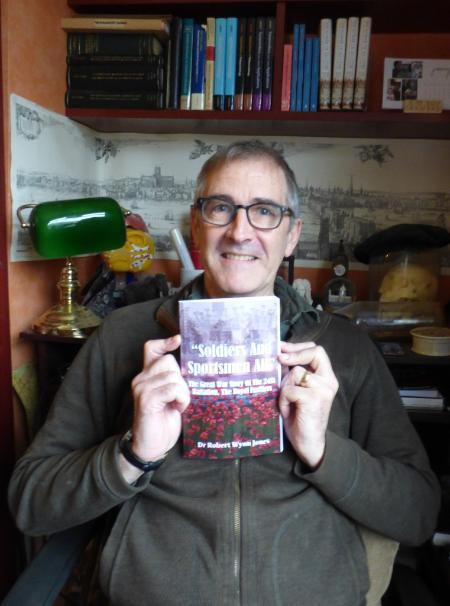Footballers in the 24th (2nd Sportsmen's Battalion, the Royal Fusiliers in the Great War
13/06/2022 - 4.44
Bob Jones
This article is adapted from my book Soldiers And Sportsmen All – The Great War Story Of The 24th Battalion, The Royal Fusiliers
Introduction
The 24th (2nd Sportsmen’s) Battalion, the Royal Fusiliers was raised in 1914, in the Hotel Cecil on the Strand in London, part of which served for a while as a Drill Hall. The Battalion was raised by a remarkable woman named Emma Pauline Cunliffe-Owen. Emma was born in 1863, to an English father, Sir Francis Philip Cunliffe-Owen, the Director of the South Kensington Museum (now the Victoria and Albert), and a German mother, Jenny von Reitzenstein, whose father, a Baron, had been an aide-de-camp to Frederick Wilhelm of Prussia. The story goes that in 1914, on the outbreak of war, Mrs Cunliffe-Owen chanced to meet two big-game hunters of her acquaintance while walking down Bond Street, and, half-jokingly, asked them why they had not yet enlisted in the Army. They in turn, and in similar vein, asked her why she had not yet raised her own battalion. And so she did. She and her husband, with the sought approval of the Secretary-of-State for War, Lord Kitchener, advertised in The Times for “Sportsmen, aged 19 to 45, upper and middle class only”, to sign up at the Hotel Cecil “at once”, to constitute a Battalion around fifteen hundred strong. In the event, the response was such that two Sportsmen’s Battalions were constituted, the 23rd (1st Sportsmen’s) Battalion, the Royal Fusiliers, on September 25th, 1914, and the 24th (2nd Sportsmen’s) Battalion, on November 20th.
The 24th (2nd Sportsmen's) Battalion went on to fight in the Battles of the Somme in July-November, 1916; in the Battles of Arras in April-May, 1917; in the Battle of Cambrai in November-December, 1917; in the First Battles of the Somme, 1918, in March-April, 1918, during the German “Spring” Offensive; and, during the Allied “Hundred Days” Offensive that eventually won the war, in the Second Battles of the Somme, 1918, in August-September, 1918, the Battles of the Hindenburg Line, in September-October, 1918, and the Final Advance in Picardy, in October-November, 1918. It suffered just under eighteen hundred casualties over the course of the Great War, including just under six hundred fatalities.
As might be expected, many of the Battalion’s recruits came from sporting backgrounds, or could at least shoot or ride. They included three professional footballers, Adams, Evans, and Purver. They also included one semi-professional player, D’Abadie. And one man, McGahey, who played first–class cricket, and who also played at least occasional top-tier football.
Adams, Lewis and McGahey
Serjeant Adams played professional football for Southend United and Fulham before enlisting in the 2nd Sportsmen’s Battalion at the outbreak of the Great War. He featured in a photograph captioned “Well-Known Footballers in the Sportsman’s Battalion” in the Aberdeen Weekly Journal in March, 1915. Alongside him in the photograph was Corporal Lewis Richard Lewis. Lewis was born in Machynlleth in mid-Wales in 1890. In his youth, he was a gifted inside-right, described by one newspaper as a “a fine strapping fellow with a good shot”. After enlisting in the 2nd Sportsmen’s Battalion, he had a trial with Southampton. He was wounded in the ankle in a shell explosion in 1916, and although he played occasional football for Queen’s Park Rangers and Southampton during a period of recuperation in 1916-1917, he was eventually forced to retire in 1917.
-and-Lewis-499x659.jpg)
Corporal Lewis (left) and Sergeant Adams (right). Source: Aberdeen Weekly Journal
Private Charles Percy – Charlie - McGahey was born into a working-class family in Bethnal Green in the East End of London on February 11th, 1871, the fifth and last child of John McGahey, a railway clerk, and his wife Elizabeth, nee Walker. Before the war, he played county cricket for Essex, as “a tall, right-handed, hard-hitting, front-foot batsman, a useful slow leg-break bowler, and a good field”, making his debut in 1894. He was part of the Essex XI that famously beat Australia by 126 runs at the County Ground in Leyton in 1899, and went on to play international cricket for the M.C.C. against Australia, on the losing Ashes tour in 1901-02. He was voted one of Wisden’s “Cricketers of the Year” in 1901, and even during the war, he continued to play cricket, on a pitch at Etaples. McGahey evidently also played at least occasional top-tier football. for Millwall, Woolwich Arsenal and Tottenham Hotspur, once breaking an opposing goalkeeper’s collar-bone with a particularly hard shot.

Private McGahey. Source: Cover of the biography entitled Cheerful Charlie …
All three men survived the war. Charlie McGahey returned to county cricket, before finally retiring in 1921, after scoring over twenty thousand runs at an average of just over thirty, and taking over three hundred wickets, at an average of just over thirty. He died of septicaemia in Whipps Cross Hospital in Leytonstone in the Municipal Borough of Leyton on January 10th, 1935, aged sixty-three, a few days after injuring a finger in a fall on a wet pavement on Christmas Eve, 1934.
D'Abadie, Evans and Purver
Private Louis Lawrent D’Abadie was born in Trinidad in 1877, the third son of Sainte-Luce and Ida Francoise. Before the war, he was educated at St Augustine’s Roman Catholic School in Ramsgate in Kent. He was a keen cricketer, and also played football for Brentford Reserves. He enlisted in the 2nd Sportsmen’s Battalion in London, his Army Service Number, 2276, indicating that he did so sometime between December 3rd, 1914 and January 6th, 1915.

Private D’Abadie. Source: Brentford Football Club Website (www.brentfordfc.com)
Serjeant Arthur Nicholas Evans was born in Horwich in Lancashire in 1887, the second son of George Evans and his wife Margaret, nee Gallaway. He grew up to be, by the standards of the age, a fine physical specimen, standing 5’10½“ tall, and weighing 11st10lb. Before the Great War, he played football for Manchester City, Blackpool and Exeter City, as a half-back and stand-in forward. At the outbreak of the war, he was living in Exeter, and working as a professional footballer, and a part-time cricket coach at West Buckland School. He enlisted in the 2nd Sportsmen’s Battalion in Exeter in November, 1914.

Sergeant Evans. Source: The Grecian Archive Website (https://grecianarchive.exeter.ac.uk)
Private Henry George Purver was born in Isleworth in Middlesex in 1891, the third son of William Richard Thomas Purver and his wife Honora, nee Mahoney. At the outbreak of the war, he was living in Isleworth, and working as a newspaper reporter, some of the time with The Times. He was also playing football for Brentford, alongside one of the team's most famous players ever - Elias Henry – Patsy Hendren (who, incidentally, went on to serve in the 1st Sportsmen’s Battalion in the Great War). Purver enlisted in the 2nd Sportsmen’s Battalion in London in July, 1915. He then married Margaret, nee Wilford, in October, 1915, and, probably on account of his newly married status, was deployed to France some time later than the rest of his battalion, in April, 1916 rather than in November, 1915.

Private Purver. Source: Isleworth World War One Website (www.isleworthww1.co.uk)
All three men were killed in the Great War. In fact, all three were officially reported to have been killed on the same day, July 31st, 1916, during the Second Phase of the Battle of the Somme.
On July 30th, a contingent of well over a hundred men from "C" Company of the 2nd Sportsmen's Battalion - largely constituted of men recruited in the West Country - was terribly cut up in a failed frontal assault on an enemy trench-line six hundred yards east of Waterlot Farm, which was part of a wider attack directed at the strategically important village-strongpoint of Guillemont. Of the 117 officers and other ranks who took part in the attack on the morning of July 30th, only twelve were present at roll-call on the evening of that day. Three of the remaining 105 were reported as having been killed on July 30th. A total of 102 men were reported as “missing” in the attack on the following day, July 31st. Forty-three of these “missing” men were later confirmed or officially assumed to have been killed; forty-seven were later confirmed to have been captured; and only twelve survived the attack and evaded capture. The bodies of twenty-seven men were never found, as was all too often the case under the prevailing circumstances. Among these men was Serjeant Evans, aged twenty-nine, who is commemorated on the Thiepval Memorial, which altogether bears the names of 72 195 “missing” of the Somme, who have no known grave. A former comrade, Corporal Frederick Pearce Hancock, was later able to shed some light on what actually happened to him, in a letter written to the Mayoress of Exeter, forwarded by her to Evans’s parents in Bolton, and finally published in The Western Times. It seems that, while in a Prisoner-of-War Camp, from which he had been released in 1917, Corporal Hancock had met another comrade of Serjeant Evans’s, who had “found him lying in a shell-hole very severely wounded. He bandaged him and made him as comfortable as he possibly could, but later on had to leave him. He said ... he felt that ... Evans must have died shortly after, as his wounds were so serious”.
The Battalion suffered a number of further casualties in separate actions on July 31st. Among the fatalities on this day were Privates D’Abadie, aged thirty-eight, and Purver, aged twenty-five, who are both commemorated on the Thiepval Memorial. Private D’Abadie is also commemorated on the Cenotaph in Port-of-Spain in his native Trinidad. He had evidently been a devout Catholic, and had attended a Mass and taken Holy Communion in the field on the day before he had been killed, which had been a Sunday. A comrade wrote of him, “Darby (as we always called him) was beloved by all, and every one of us will, deep in our hearts, treasure his memory as one of the finest men and truest comrades we ever had the good fortune to meet”. Private Purver’s obituarist in the Middlesex Chronicle wrote of him, “The game of football has lost an ardent and clever devotee, and Isleworth a most popular and charming fellow”, adding that he had “latterly gained ... prominence particularly as a prolific goal getter in the centre forward position in the Brentford Football Team”.
Biography
Dr Robert Wynn – Bob - Jones is a retired professional geologist and palaeontologist, an interested amateur archaeologist and historian, and an occasional walking tour guide. He is also the author of a number of non-fiction books, including “Soldiers And Sportsmen All – The Great War Story Of The 24th Battalion, The Royal Fusiliers”. He is a member of the Western Front Association and the Royal Fusiliers Historical Society. And he is proud to have been a contributor – albeit a minor one – to the Thiepval Database Project, the essential aim of which is to put faces to the names of the “missing” of the Somme. He lives in London.
Bob Jones can be contacted via e-mail at: lostcityoflondon@sky.com



/prod01/wlvacuk/media/departments/digital-content-and-communications/images-2024/Diane-Spencer-(Teaser-image).jpg)
/prod01/wlvacuk/media/departments/digital-content-and-communications/images-18-19/220325-Engineers_teach_thumbail.jpg)
/prod01/wlvacuk/media/departments/digital-content-and-communications/images-2024/240509-Menopause-Research-Resized.jpg)
/prod01/wlvacuk/media/departments/digital-content-and-communications/images/Maria-Serria-(teaser-image).jpg)
/prod01/wlvacuk/media/departments/digital-content-and-communications/images-2024/241014-Cyber4ME-Project-Resized.jpg)
/prod01/wlvacuk/media/departments/digital-content-and-communications/images-2024/240315-Research-Resized.jpg)
/prod01/wlvacuk/media/departments/digital-content-and-communications/images-2024/BDA-group-photo.jpg)